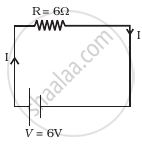Advertisements
Advertisements
प्रश्न
The potential difference applied across a given conductor is doubled. How will this affect (i) the mobility of electrons and (ii) the current density in the conductor? Justify your answers.
उत्तर
Mobility of electron `mu = (v_d)/E = (v_dl)/V`
as `E = V/l`
Hence, `mu prop 1/V`
If V becomes 2V, the mobility will become half. The current density is given by
`J = n ev_d`
J = `n e.(eVtau)/(ml)`
J = `(n e^2Vtau)/(ml)`
J ∝ V
When V become 2V current density will become twice.
APPEARS IN
संबंधित प्रश्न
Derive an expression for drift velocity of free electrons.
Estimate the average drift speed of conduction electrons in a copper wire of cross-sectional area 2.5 × 10−7 m2 carrying a current of 1.8 A. Assume the density of conduction electrons to be 9 × 1028 m−3.
(a) drift speed
(b) current density
(c) electric current
(d) electric field
On the basis of electron drift, derive an expression for resistivity of a conductor in terms of number density of free electrons and relaxation time. On what factors does resistivity of a conductor depend?
Why alloys like constantan and manganin are used for making standard resistors?
A conductor of length ‘l’ is connected to a dc source of potential ‘V’. If the length of the conductor is tripled by gradually stretching it, keeping ‘V’ constant, how will (i) drift speed of electrons and (ii) resistance of the conductor be affected? Justify your answer.
Obtain the expression for the current flowing through a conductor having number density of the electron n, area of cross-section A in terms of the drift velocity vd .
The position-time relation of a particle moving along the x-axis is given by x = a - bt + ct2 where a, band c are positive numbers. The velocity-time graph of the particle is ______.
- Consider circuit in figure. How much energy is absorbed by electrons from the initial state of no current (ignore thermal motion) to the state of drift velocity?
- Electrons give up energy at the rate of RI2 per second to the thermal energy. What time scale would one associate with energy in problem (a)? n = no of electron/volume = 1029/m3, length of circuit = 10 cm, cross-section = A = (1mm)2

Explain how free electrons in a metal at constant temperature attain an average velocity under the action of an electric field. Hence, obtain an expression for it.
